It is frustrating to witness a lawn mower suddenly stuttering and losing power. Since the problem won’t go away like that, you need to find the cause of it and fix it.
Common reasons your lawn mower loses power are clogged air filters, poor fuel quality, blocked fuel filter and lines, damaged spark plug, inadequate engine oil, dirty carburetor, and overloading. To fix the problem, start by cleaning the oil and fuel filters, followed by engine and oil checks.
This guide will explore all the reasons behind the lawn mower losing power in detail and how to diagnose and prevent the condition from happening again.
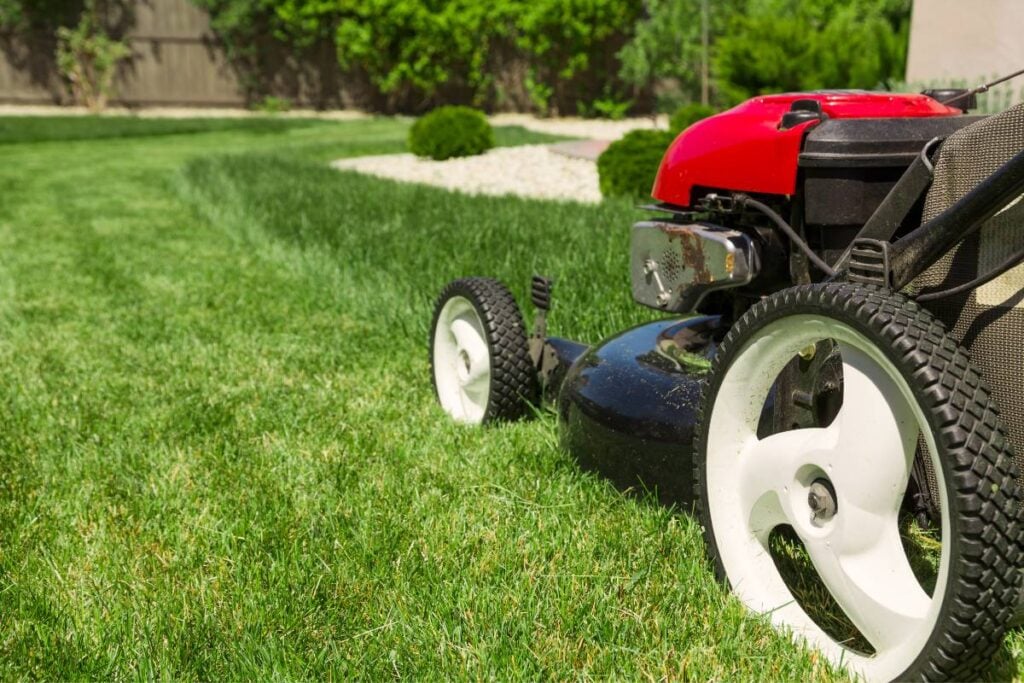
The lawn mower is losing power – What should I know?
Since a lawn mower is a machine, it won’t come without flaws.
There could be numerous reasons behind a mower losing power.
If you have this problem, check a few things that might be involved and are easy and fast to check:
- Mower deck height setting
- Condition of the mower blades
- Condition of the deck – whether it is clean or caked with grass
If everything is fine, consider inspecting other things, for example:
- The condition of the air filters
- The fuel filters and lines. Check for signs of corrosion and blockage.
- Dirty spark plugs
- Too much or too little oil
- Carburetor’s condition
These are some major problems that can make your mower lose power.
So, let’s begin with the discussion and the solutions right away.
1) Overloaded mower
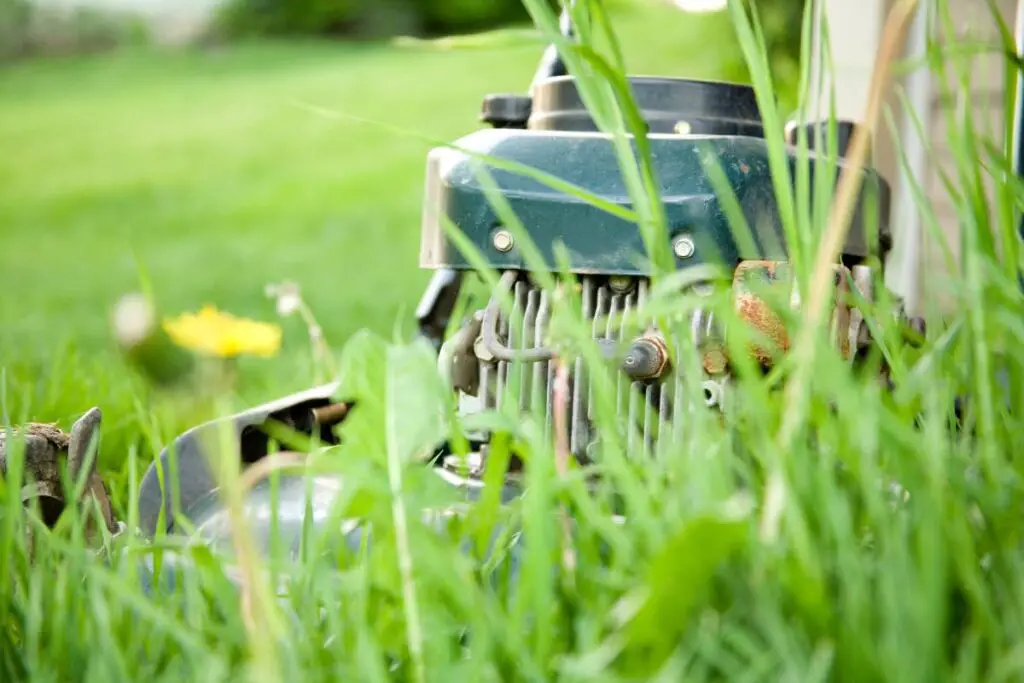
Your lawn mower will lose power if it gets overloaded.
Excessive load makes your mower work harder than normal because you will operate it during challenging conditions.
As a result, it will utilize maximum strength and ultimately lose power.
A lawn mower can overload due to several conditions:
High speed
Excessive ground speed can overload the mower and make it lose power.
Slow down the mower’s speed, especially on the inclined surfaces, so it can handle the grass cutting properly without any load.
Tall, wet, and thick grass
Your mower will work harder if the grass is thick, tall, and wet.
Always mow dry grasses. As for the tall grass, you should often mow to prevent the grass from becoming taller than 3 inches.
If the grass ever gets taller than 3 inches, move your mower deck to the highest position for the first cutting and lower it in the second.
Dirt buildup in the deck
Grass and debris can get stuck in the mower deck, especially on the underside.
It will make your engine work harder due to jammed blades, causing power loss.
Wet grass clippings will stick in the mower and clog.
Try a silicone spray at the bottom of the deck to stop the grass from sticking.
Scrap the deck mower often to prevent the deck from clogging.
Dull blades
Rounded dull blades can make your engine work harder because the grasses do not cut properly.
As a result, it strains the engine and makes your mower lose power.
You should keep the blades sharpened and replace the damaged blades.
Sharpen the mower blades every 25 hours.
2) Low deck setting
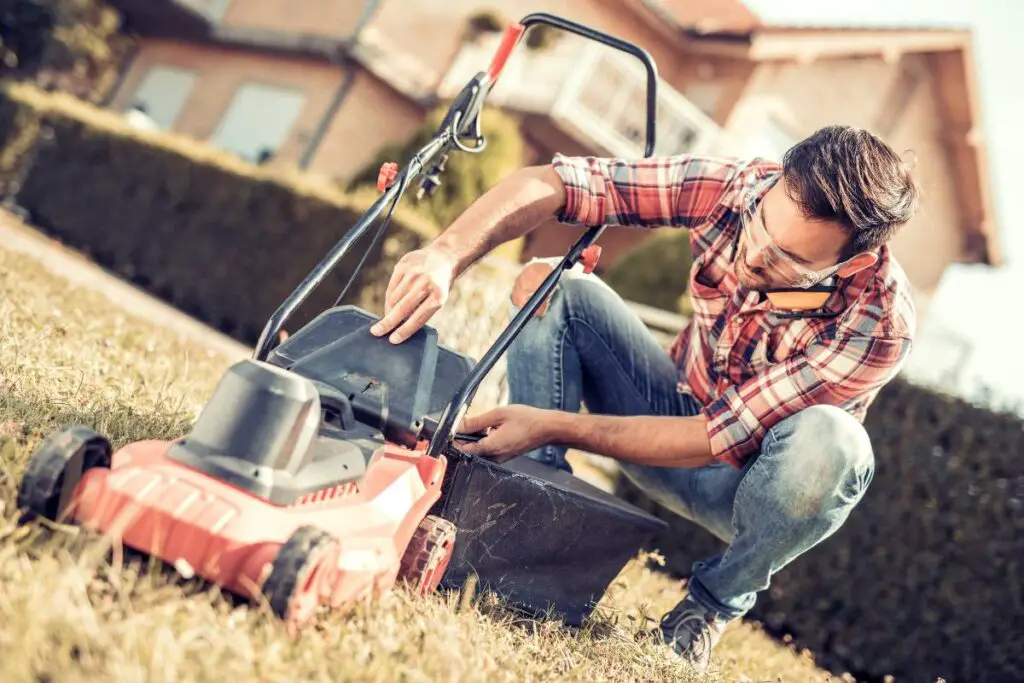
Generally, you should not remove more than 3rd of the height of your yard in any mowing session. It is for the good of your lawn.
However, following this rule strictly can make your mower lose power.
The mower’s motor gets overwhelmed if the deck is set low, but your grass height is above 3 inches.
The mower will work hard to cut the grass, overwork, and lose power faster.
Ultimately, it may stall and die without cutting sufficient grass.
At what height should I set the mower deck?
You should raise the mower deck to the highest position if the grass is too tall. Also, observe the 1/3rd rule.
It is quite helpful for the electric mowers as they will quickly cut off the thicker and taller grass.
3) Clogged air filters
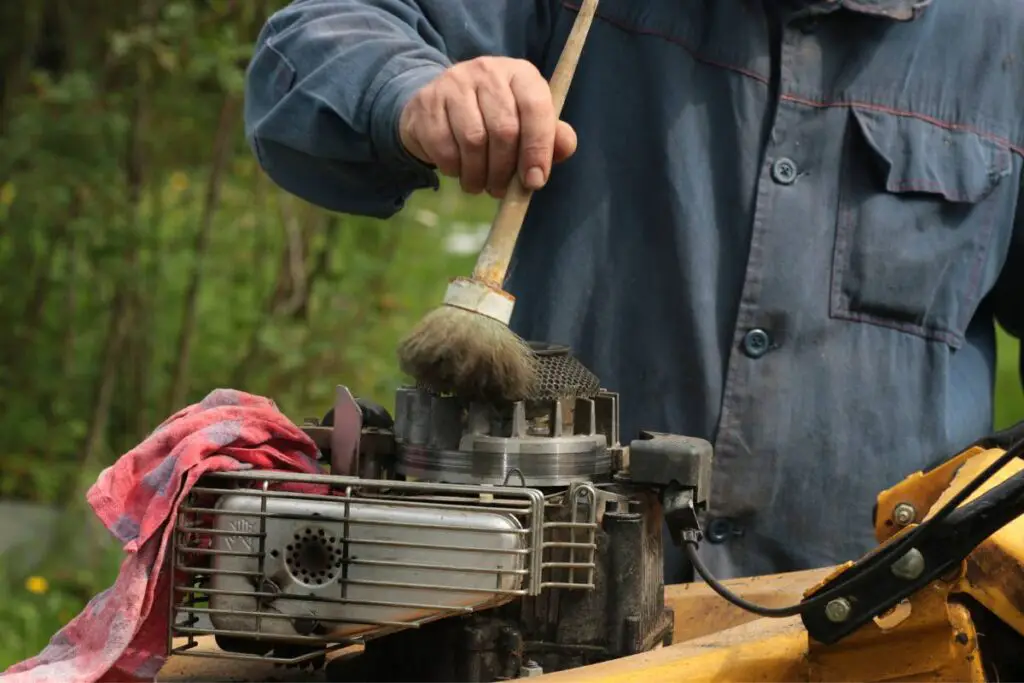
Blocked air filters can make your mower lose power.
The engine will need air to run. But if the air gets restricted due to the clogged air filters, the engine will suffer and lose the power to run at its best.
You should check the air filters to clean or replace them from time to time.
Looking for gardening supplies? We have tested 100's of products before recommending them to you guys. Check out our best pick below:
| Image | Gardening Supplies | Best Price? |
|---|---|---|
 Top
Top Top
Top | Raised Garden Bed Kit | Check On Amazon |
 | XLUX Soil Moisture Meter, Plant Water Monitor, Soil Hygrometer Sensor for Gardening, Farming, Indoor and Outdoor Plants, No Batteries Required | No Results |
 Top
Top Top
Top | 82 Pcs Garden Tools Set and Extra Succulent Tools Set | Check On Amazon |
 | Joeys Garden Expandable Garden Hose with 8 Function Hose Nozzle, Lightweight Anti-Kink Flexible Garden Hoses, Extra Strength Fabric with Double Latex Core, (50 FT, Black) | No Results |
 Top
Top Top
Top | Dual Chamber Compost Tumbler | Check On Amazon |
 Top
Top Top
Top | Sunnyglade Plant Stakes | Check On Amazon |
 Top
Top Top
Top | Organic Cold Pressed Neem Seed Oil | Check On Amazon |
 Top
Top Top
Top | Mighty Mint Gallon :-Insect and Pest Control Peppermint Oil | Check On Amazon |
 Top
Top Top
Top | Scotts DiseaseEx Lawn Fungicide | Check On Amazon |
 Top
Top Top
Top | Jacks Classic 20-20-20 All Purpose Fertilizer | Check On Amazon |
 Top
Top Top
Top | 30,000 Seeds Pollinator Attracting Wildflower Mixture | Check On Amazon |
 Top
Top Top
Top | Survival Vegetable Seeds Garden Kit-Over 16,000 Seeds | Check On Amazon |
Cleaning foam air filters
If your lawn mower has foam filters, follow the following steps to clean or replace them:
- Remove the air filter from the filter housing. Do not let the dirt fall into the engine’s air intake.
- Wash the filter with soap water and rinse it until the soap gets washed away and the water runs clean.
- Place the filter in a bright place for drying.
- Once the filter is dry, use filter oil to saturate it. Do not saturate too much so that the oil starts dripping.
- Put the filter back in its place.
- While cleaning the filter, check it closely. If you find any brittle, tear, or damage, replace it with a new one.
Cleaning paper air filters
Follow the following steps if you have paper air filters:
- Remove the filter from the filter housing without letting the dirt fall into the engine’s air intake.
- Tap the filter with your finger to dislodge the loose dirt. Avoid using any air compressor here.
- Hold the filter up to the light source and try looking through it.
- If you cannot see anything through the filter, you should replace it. If you can see the light through the filter, put it back.
4) Poor fuel quality
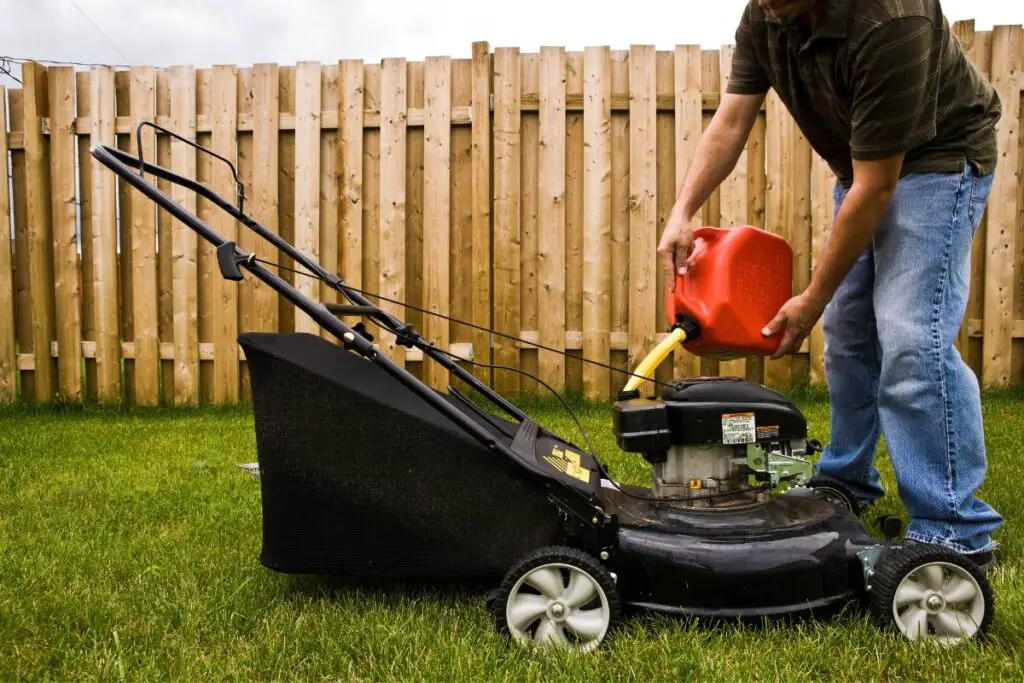
Bad or old fuel is one of the major causes behind a mower losing power.
Gasoline breaks down after 30 days of purchase and becomes less effective.
This fuel will evaporate the moisture content and leave sticky deposits in the fuel system, creating fuel blockages.
Most mowers will need gasoline containing 87 octane rating and 10% or less ethanol.
Using fuel with ethanol higher than 10% will attract moisture and corrode the engine.
Due to the bad fuel, the stickiness will create fuel blockages and stop your mower’s internal parts from running properly, ultimately leading to power loss.
How can I remove the stickiness?
You should drain the old or bad fuel from your lawn mower and refill it with new and good quality oil suitable for your mower.
For removing the fuel, use a fuel siphon, like, GasTapper Fuel Transfer Pump – Gas Siphon Pump for Gasoline, Oil, Diesel, Water, Liquid, Fluid w/ 9 Ft Hose – Portable Hand Gas Pump Includes Brass Tip Weight and Pinch Clip – 3.5 Gls/Min.
Mowers have 2 types of engines, and the fuel type will vary:
- 2-cycle engines will need unleaded gasoline mixed with oil.
- 4-cycle engines will need unleaded gasoline without any oil mixture.
You can also use Sea Foam SF-16 Motor Treatment – 16 oz., White to stabilize the fuel, reduce moisture, and clean the fuel system.
5) Dirty carburetor
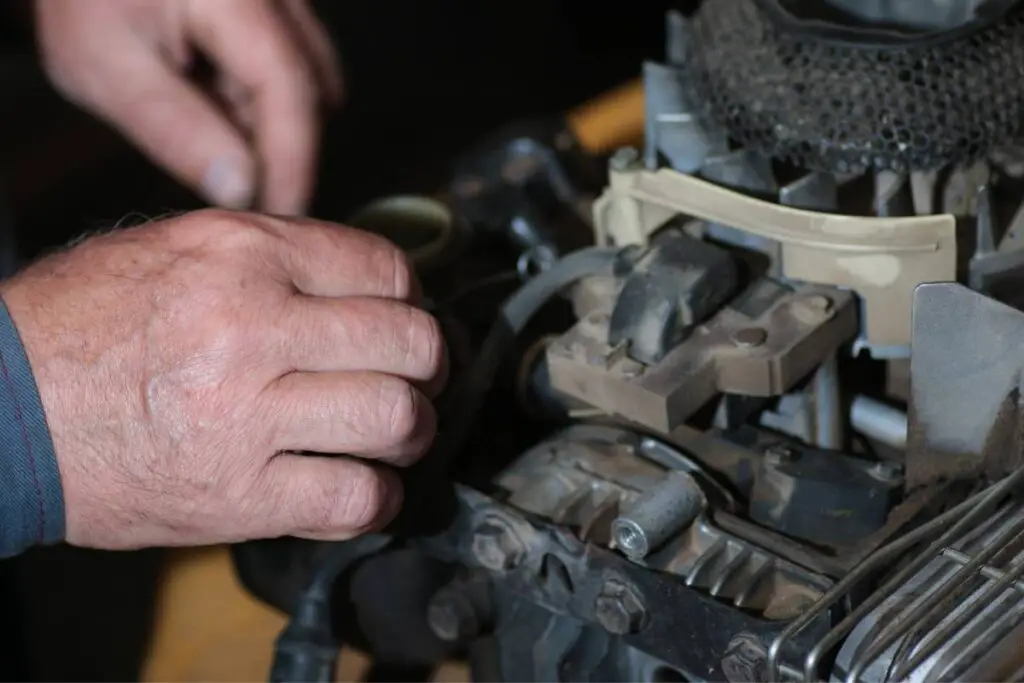
The lawn mower’s carburetor plays a vital role. It regulated the correct amount of fuel and air in the mower’s engine for running.
Without the right amount of gas and air, your mower will lose power and stop running at its best.
Due to the bad or old fuel deposits, the carburetor will become dirty, sticky, and have crusty spots.
Clean the carburetor with or without removing them from the mower.
Spray the carburetor
If you want to clean the carburetor without removing it, use a carburetor cleaner.
Remove the air filter and spray some carb cleaner or carb aerosol in the air intake.
A suitable carburetor cleaner is Gumout 800002231 Carb and Choke Cleaner, 14 oz. (Pack of 6).
After the spray dries, turn on your engine and check if it is running properly without any power loss.
If it still does the same thing, you may have to remove the carburetor for a thorough cleanup.
Clean the carburetor thoroughly
Gather tools – pliers, screwdrivers, sockets, and ratchets.
Please take a photo of the carburetor before removing it so you can reassemble everything in place after cleaning it.
Now, let’s get to the steps:
- Remove the throttle and choke cables if your mower has them.
- Remove the filter housing and unscrew the nuts and screws holding the carburetor.
- Remove the springs, too, to stop the carburetor from stretching. You will have to twist the carb to remove the springs.
- Watch the gasket to ensure you don’t tear them.
- Remove the bottom screw from the float bowl and detach the bowl without damaging the o-ring.
- Check the stem hanging down from the carb’s center for clogged holes.
- If the holes are clogged, use a thick wire to clean them using a flashlight. Spray it with the carb cleaner.
- Check the carburetor for white buildup. The white crusts will be the leftovers of the fuel additives, including ethanol.
- Try removing the white crusts as much as you can. Use the cleaner spray.
- If you have taken out the carburetor, you can sink it in a container filled with coke or carburetor cleaner.
- Put everything back in reverse order to reassemble your carburetor.
- Add fresh fuel to the engine with some fuel stabilizer and start your mower to check its functionality.
6) Clogged fuel lines and filters
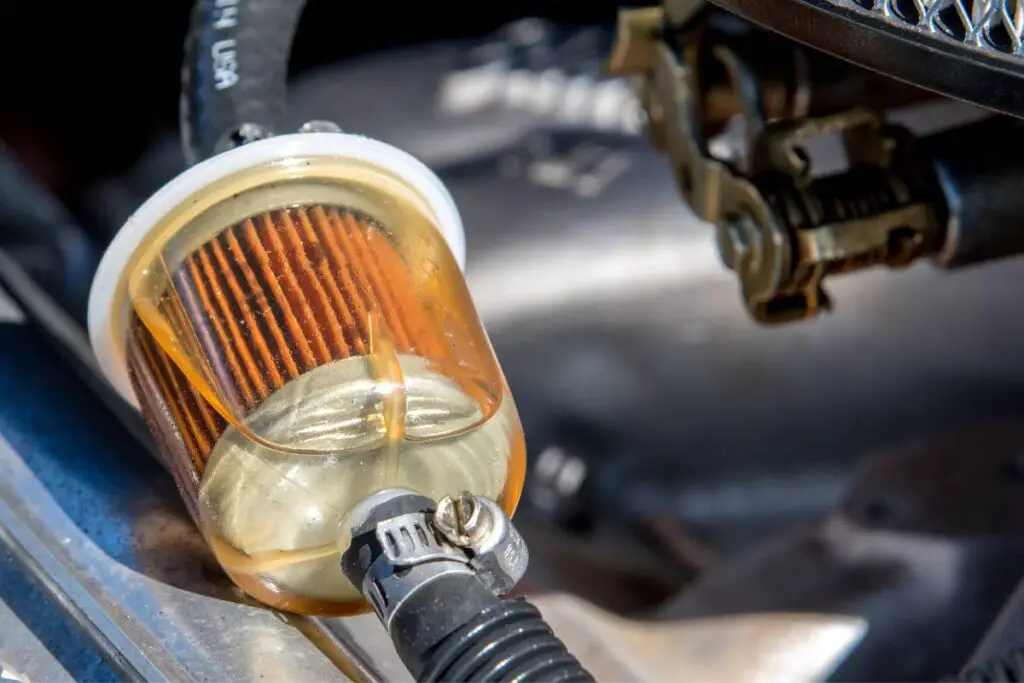
Fuel blockages in the fuel lines and filters can make your lawn mower lose power while operating and reduce its running ability.
You should check the fuel flow by isolating areas of the fuel lines.
Use the clamps to start and stop the flow.
It will let you know whether the fuel runs through each line properly.
How can I clear the fuel lines?
Remove the line from the mower and spray some carburetor cleaner to clean the fuel lines.
Next, use a can of compressed air to blow the air through the line and clear the clogging.
If the clogging is too much or you notice some damage signs, you should replace the filter with a new one, for example:
- ¼ Inch ID Fuel Line for Small Engines 6-Foot Length.
- CocoMocart 9.85-Foot Length Stretchy 1/4 Inch ID Fuel Line+20pcs 2/5″ ID Hose Clamps for Kawasaki Kohler Briggs & Stratton Small Engines.
What to do with the fuel filters?
Replace the fuel filters annually during maintenance time.
Turn off the engine with the shut-off valve or use pinch pliers to crimp the fuel line and stop the fuel flow.
Remove the old filter and replace it with a new one.
While installing, ensure the arrow points toward the fuel flow toward the carburetor and away from the fuel tank.
7) Bad spark plug
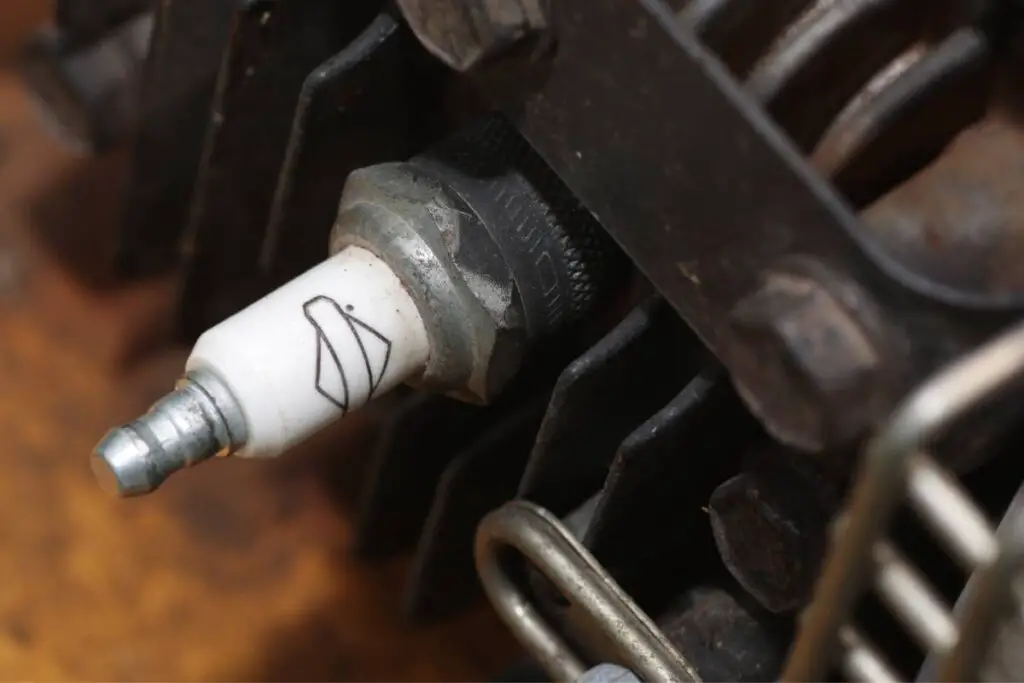
A filthy spark plug creates an intermittent spark, leading to power loss in the mower.
Check your spark plug for signs of carbon, dirt, and oil deposits on the tip.
Should I replace the spark plugs?
If there are any such deposits, replace the plug with a new one.
However, if the dirt is less in amount, you can clean it with a wire brush and reuse it instead of replacement.
8) Low engine oil
The engine oil used inside the lawn mower keeps the internal components well-lubricated.
When the engine crankcase’s oil level decreases, the friction will increase.
As a result, the engine becomes hotter and starts losing power to work efficiently.
If you do not fix the problem sooner, the components will damage over time, and you will have to pay for expensive damages.
Filling oil before operation
Before running the mower, you should check the oil level.
If the level is lower than normal, add some extra oil.
Avoid using the mower in inclined or hillside areas for too long. It can also lead to oil leakage and power loss.
9) Overfilled engine
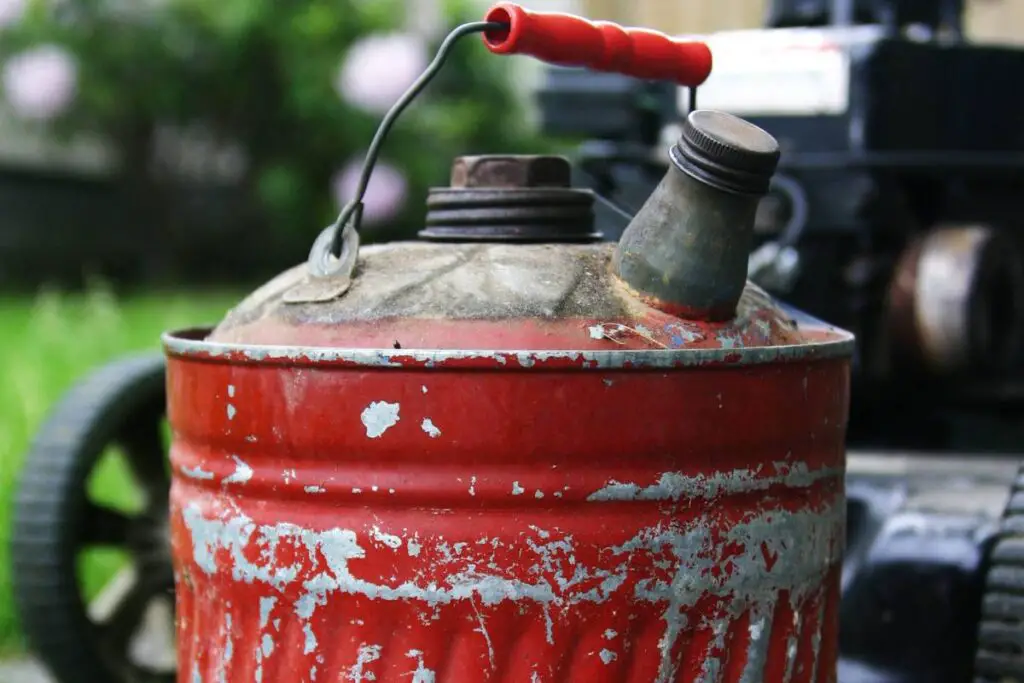
Overfilling the fuel tank will make your engine smoke because the mower will burn this oil first.
Excess smoke will block the air filters and stop the airflow.
Without adequate airflow, your mower’s engine won’t run at its best and will start losing power.
If you continue to run your engine with excess oil, it will damage the seal, hydrolock the engine, and bend the pistol rod.
What should I do if I have already overfilled the fuel tank?
If you have already overfilled the fuel tank, remove a little oil from the tank using an oil evacuator, drain plugs, or turkey basters.
If you have overfilled in small amounts, there is no need to remove it. Let the mower burn the excess oil.
After the oil has finished burning, the smoke should disappear, and the filters will become clear.
In the future, avoid overfilling your tank.
10) Clogged engine air circulation passages
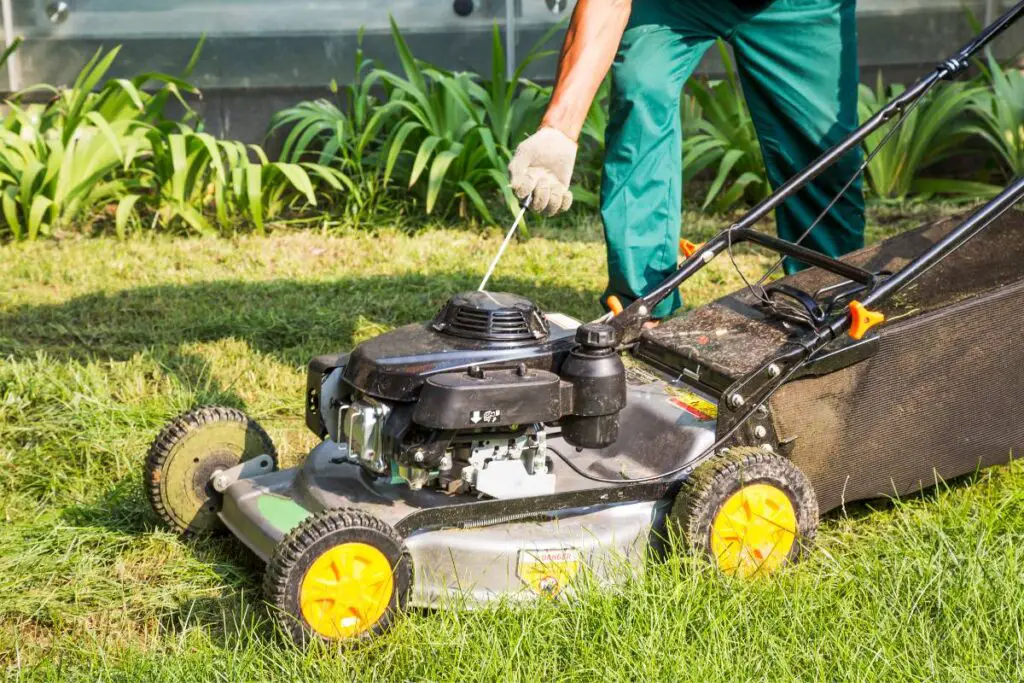
Adequate air circulation around the mower engine is needed for the engine to cool down and prevent power loss.
If the air circulation passages are clogged, the engine will not cool down and will lose power.
Keep the airflow passage clean.
While mowing, dirt, grass, and other debris can accumulate around the engine and block the air passage.
Open the engine shroud and remove the grass clippings, dirt, and debris around the engine to clean the passage.
11) Dirty cooling fins
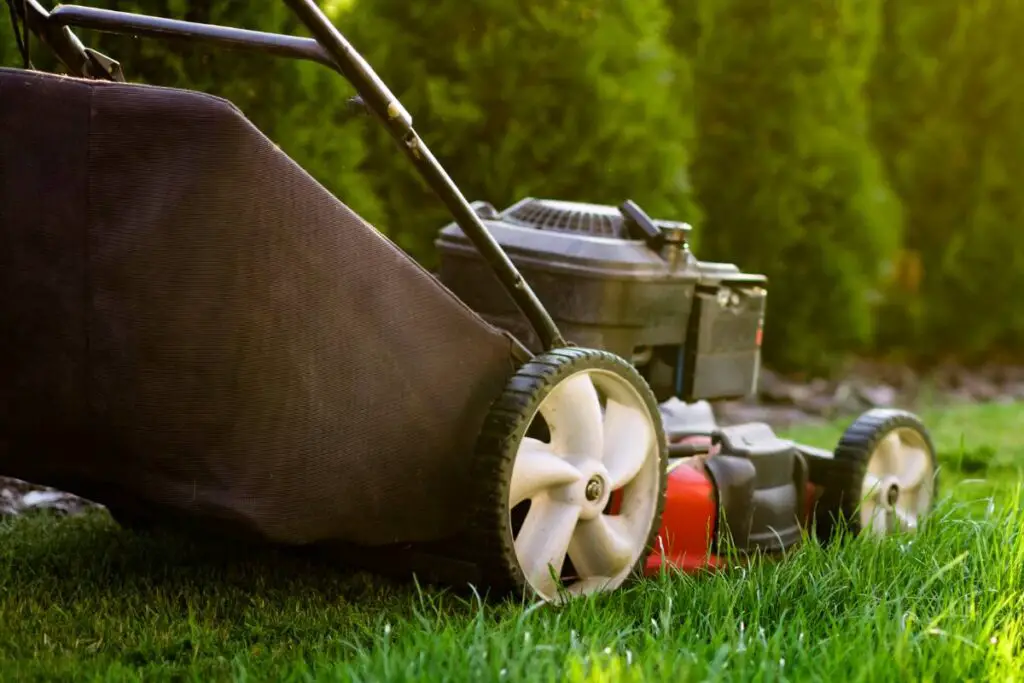
Just like the air passage, the cooling fins of the mower can also lead to power loss if they are dirty.
The cooling system contains these fins, which help to cool down the mower.
If the fins are dirty or damaged, it restricts air circulation, overheats your mower, and leads to power loss.
You should keep the fins clean for adequate air circulation and prevent blockage.
How do I clean the cooling system?
Open the engine cover and clean the fins.
Remove the accumulated dirt and grass around the engine and the cover.
If the fins are damaged, you should replace them by consulting a professional.
Other reasons behind power loss
Drive belts
The energy the mower blades need for running transfers from the engine to the blades through drive belts.
Damaged belts will restrict this energy transfer and lead to power loss.
Change the belts if you see signs of damage.
Mower batteries
Batteries are important for electric mowers.
However, they are temperamental to the cords connected to the outlets.
Batteries are vulnerable to extreme temperatures and have short shelf lives.
Old or damaged batteries will make your mower lose power a few minutes after running.
Change the batteries regularly to keep your mower going.
Low octane fuel
For older gas mowers, the octane level in the fuel determines the mower’s power output.
Low octane level will make your mower lose power in the middle of mowing. 87 octane rating is an ideal one.
However, there is no need to use high-octane fuel as it won’t show any differences. The older models do well with mid-range fuels.
Final thoughts
Lawn mowers will come with defects and frustrations. So, prepare yourself to face those defects and how to fix them. Most lawn mowers can lose power due to the lack of air or fuel.
Common reasons are dirty filters, blocked fuel lines, dirty carburetor and spark plugs, plugged mower deck, and incorrect fuel levels. If your mower is losing power, consult this article to identify which problem your mower is facing and how you can resolve it.
If you have exhausted all the above reasons and haven’t solved the issue, consult an expert to fix the mower.
Can electrical problems make your mower lose power?
If the problem is electricity-related, the mower engine will lose power during operation due to poor connections or bad wires. You need an electrician to fix the problem.
Can I use premium gas for the lawn mowers?
The premium gas contains a high octane rating of 93. Premium gas won’t make any difference to your mower and will hurt your pocket. You can use premium gas, but it is unnecessary.
